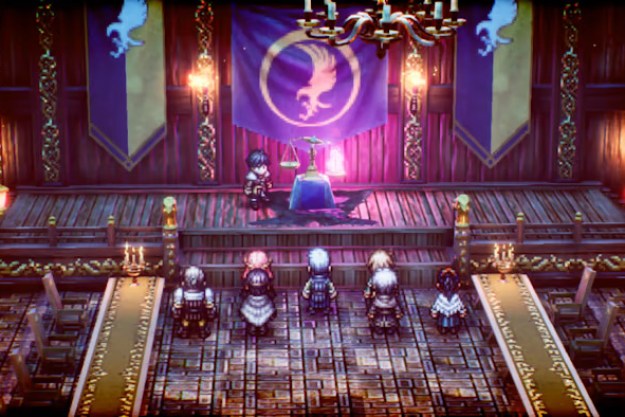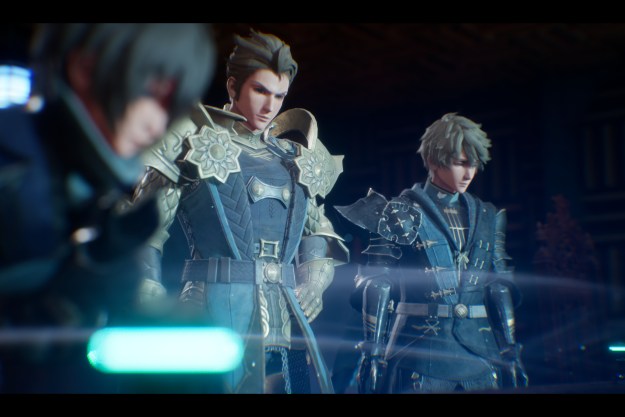The Dark Souls series is notoriously challenging, and while it has become popular among gamers in the last few years exactly for that difficulty, it remains a bit inscrutable and overwhelming for many players. Dark Souls III is arguably a more easygoing Souls game than its predecessors, however, in that it gives players a little more leeway as they learn and provides something of an easier time getting into the game. It’s still no walk in the park, but it might not be as ruthless as previous titles.
- Take your time and don’t worry about dying
- Fighting bosses isn’t about reflexes, it’s about outsmarting them
- Try dodging toward attacks rather than away from them
- Get yourself a bow ASAP
- Leveling isn’t as ridiculous as it looks
- Don’t only focus on a weapon’s physical damage
- Concentrate on making progress and avoiding discouragement
- Know when to back off
- Look for alternative ways to kill enemies
- What is Ember and how do you restore it?
- Begin each encounter with full health (if possible)
- Let’s talk about parrying
Two expansions have been released since Dark Souls III launched in 2016, offering even more terrifying environments and bosses for brave travelers. You might be afraid of getting into the series due to its notorious difficulty, but it is possible to get into Dark Souls III — and even fall in love with it. With a little insider information and a lot of patience, anybody can become a hollowed medieval warrior and a skilled smasher of hideous monstrosities.
In this guide, we’ll give you a slew of tips and strategies that will help you on your journey — from explaining the leveling system to recommendations for easy-to-use builds, and even walking you through the combat. So if you’re new to the series, you’re sure to find something useful here. This is our Dark Souls III guide for beginners.
Recommended reading:
- Demon’s Souls is getting a $90 digital deluxe edition
- Twitch streamer uses dance pad to finish Dark Souls 3 with level 1 character
- Sekiro: Shadows Die Twice beginner’s guide
Take your time and don’t worry about dying
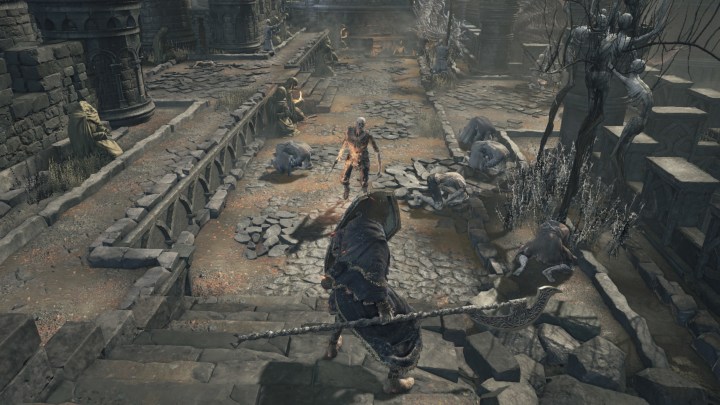
You are going to die in Dark Souls III. Maybe it’ll be because you went up against something you weren’t ready for. Sometimes it’ll be because your skills weren’t up to par. Other times it’ll be because an enemy snuck up behind you or because his sword went through a wall in a way you didn’t expect. These things happen and they’re a fact of life in Dark Souls. Each time you reawaken from a death, you begin at your last bonfire, which function as Dark Souls’ safe havens. Treat these as home bases and each step you take away from them as a venture out into the unknown. If you return and rest, you can travel between bonfires instantly or refill your health-restoring Estus Flasks — just keep in mind that most enemies you’ve killed will respawn whenever you do.
The first time you find a new bonfire and you set out to see what’s beyond it, you’re not necessarily trying to make progress, you’re trying to fill out the map in your head and learn about what you’re going to face. If you die, yes, you do drop all the souls you’ve accumulated from defeating enemies, which function both as currency to buy things and a way to increase your character’s stats. However, you’ll always collect more. There’s an unlimited number of enemies and souls, so even if you drop them all and then lose them after dying once, you can return to the same spot and recollect them; die twice and the souls are gone forever. But you’ll be collecting more momentarily. Don’t sweat the loss. Focus on learning from the experience.
Fighting bosses isn’t about reflexes, it’s about outsmarting them
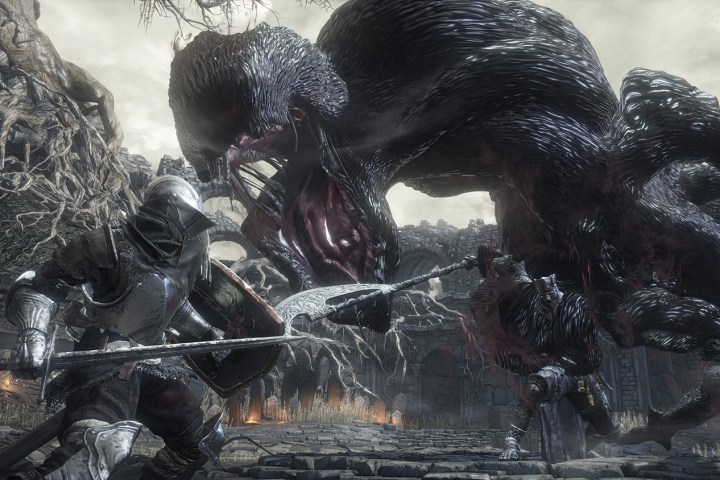
You can say this about everything in Dark Souls III: being especially good at the game, with quick button-pushing reflexes, isn’t as important as you might think. Most players assume they need a high degree of skill to play Dark Souls, and that turns people off to the series. But while having a fast thumb will certainly save your life at times, it’s not what’s going to get you through the game.
The fact is, dexterity pales in comparison to the usefulness of experience and learning. Every encounter with an enemy, and especially with a boss, is about learning how they move, attack, and react to your attacks, as well as what you’re capable of and how you can react to them in return. You don’t need amazing “gamer reflexes” if you know how to read your enemies, and every one of them has signs that give you the information you need to react to what they’re about to do.
If you want to play Dark Souls III, you need to be observant rather than quick. Watch your enemies, and pay attention to how they’re beating you. You’ll quickly learn what attack they’re about to launch when they take a menacing step forward, or whether you’ll need to leap clear of an attack to avoid getting popped in the face with a shield. Get good at dodging, blocking, and watching. The rest will follow.
Try dodging toward attacks rather than away from them
Dark Souls uses a stamina system to dictate what you’re able to do and for how long. The stamina is depicted by a green bar that depletes every time you dodge, roll, swing your weapon, or block an attack, and it only refills when you’re not doing those things (and slowly if you’re holding your shield at the ready). You don’t have a ton of stamina, and you’ll often find as you dodge backward away from enemy attacks that you run out of stamina as your enemy keeps charging forward, pressing the offensive. It’s a good way to get killed.
Instead of dodging away from attacks, try dodging sideways or, more often, forward toward the enemy. If you time a dodge correctly, you’ll be immune to just about any attack, so while it seems suicidal to roll forward, it’s actually advantageous. Many bosses, especially big ones, are at a disadvantage when you get in their faces. The direction you choose to dodge can often mean the difference between coming up swinging — and pulling out a victory — or spending a fight constantly on the retreat.
The main reason for dodging toward enemies is that it puts you close enough to them to strike — while still avoiding their attack. It won’t do you a lot of good to continuously dodge backward if you’re too far to actually land an attack. Watch the enemy’s movements and roll toward them just as they swing their melee weapon and you’ll avoid it and be close enough to deal damage. If you’re lucky, you’ll get behind them, where you can execute a critical backstab attack. Check the video above for reference.
Get yourself a bow ASAP

At the start, you might have chosen a sorcerer or a naked brawler as your character class in Dark Souls III, but even if it seems counter-intuitive, go out of your way to acquire a bow as early as you can. You might find one in the game’s first big area past the first boss, and if not, you can buy one in the Firelink Shrine, a location you’ll return to throughout the game as you level up and resupply.
You can also equip up to three weapons for each hand and switch between them quickly, which means you can pull out your bow whenever you want, so long as you have arrows equipped to go with it. Trust us when we say you’ll want them. Dark Souls III is full of moments and locations where you’ll have a positional advantage over a particularly annoying enemy, where they can’t reach you but you can snipe away at them. There are bad guys early on in the game that you’re going to want to deal with at a distance, and having a well-stocked bow will mean you can take advantage of those moments and save yourself some sanity, as well as a few deaths. You can also use your bow to draw enemies out of groups or to fight in locations that are better suited to your play style –something you should do anyway whenever you can.
The bow can be a little tricky to use if you haven’t played a Souls game before. There are two ways to use it — by locking onto an enemy and firing, or by zooming in for a more precise shot. To use the first technique, simply lock onto an enemy and press the top shoulder button associated with the hand you have the bow in (R1 or L1 on PS4 and RB or LB on Xbox One). The issue with this is that if you’re close enough to lock on, you’re sort of defeating the purpose of using the bow in the first place.
That’s why it’s recommended to use the second technique — zooming in for a more accurate shot. To do so, you’ll need to two-hand your bow by pressing triangle on PS4 or Y on Xbox One. Once you’re two-handing the bow, press and hold L1 on PS4 or LB on Xbox One and you’ll enter a zoomed mode, with a reticle in the center of the screen. While holding L1 (or LB) you can then use R2 (or RT) to shoot enemies — like you would with a sniper. Check out the video above for reference.
Leveling isn’t as ridiculous as it looks
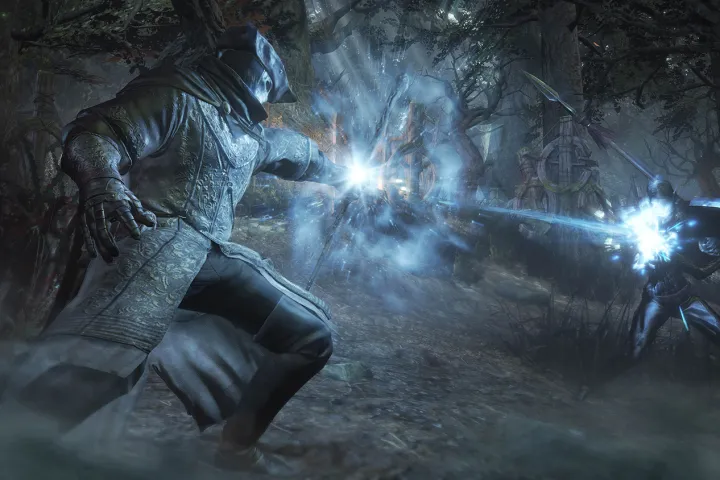
Maybe the most obtuse part of Dark Souls III for the starting player is its leveling system. You have all these souls you accumulate that you can bring to Firelink Shrine, and once you have enough, you can buy a new level, which allows you to increase a single character stat by one point. There are a bunch of stats, however, and it’s not exactly clear how important each one is or what they might do.
Though having so many stat numbers to parse can be intimidating, it’s likely that you won’t need to worry about the majority of these numbers. If you want to be a sword-wielding, shield-carrying knight, for example, you’ll want to invest chiefly in your Strength stat, because that determines how powerful your strikes are and how well you can block with your shield.
You’ll also want to amp stats such as Vigor, which dictates health; Endurance, which controls your stamina bar; and Vitality, your defensive capabilities and equip load, on a case-by-case basis depending on your play style. The rest — Dexterity, Faith, Intelligence, and Luck — aren’t really important to your kind of character if you’re focusing on a strength driven knight. You can more or less ignore those stats for that particular build.
Put another way, your stat numbers allow you to dictate what kind of character you want to play as. Whereas magic-based characters will want to put their points into Intelligence and Faith, long-ranged fighters should focus on Dexterity. Players who want heavy armor and big swords should go for Strength.
A good way to determine what you want to invest in is to pay attention to the weapons you like to use. Weapons will often have stat requirements with a specific icon at the bottom of their descriptions, telling you how high that particular stat needs to be in order for you to use that particular weapon. So you if you have a spear you think is cool (and feels good to use), spend some souls on Dexterity; if you want to cast a particular spell even though you largely are a knight, invest in Intelligence. It’s all based on what you want to do, and any character can be anything. But generally focusing on a particular kind of fighting style, and the stats that go with it, will let you maximize your capabilities.
Leveling up your stats is great — a little extra Endurance might give you the last-second dodge you need, or a boost in health might let you withstand an extra attack or two for a clutch moment — but don’t agonize over it. Level gains in Dark Souls III are pretty incremental, so use levels as a way to get the necessary stats you need to use the gear you want.
Keep in mind, the more you level up, the more each subsequent level will cost. For instance, our Dark Souls III character is a level 193, meaning it requires 280,785 souls to reach level 194. You can also “re-spec” or reallocate attributes by visiting Rosaria, Mother of Rebirth in Cathedral of the Deep.
Don’t only focus on a weapon’s physical damage

Players familiar with role-playing games like Dark Souls III will be expecting to find new swords and armor constantly, and to always be searching for the best gear to use for a particular situation. There’s some of this at play in Dark Souls III, but not as much as you might think.
The stats attached to particular weapons to tell you if they’re better than what you’re using can be hard to understand in Dark Souls III, and some weapons “scale” based on how high your particular stats are. Keep an eye out for weapons that might be stronger than what you’re using, but for the most part, you’ll want to pay more attention to how weapons feel and what they do than what their numbers say.
For example, as a knight, you’ll start with a Straight Sword, which is a pretty solid weapon that will scale as your character does (it scales with the Strength stat). You might find other cool weapons, such as pikes or great swords, that seem interesting but aren’t stronger than what you started the game with. Try them out anyway — you may find that you like the way a weapon handles better than what you’re using, and each one is different. Having gear you can use effectively is more important than how hard it hits. You can always upgrade weapons to be stronger with souls and Titanite items you find in the world. If you carry a huge great sword that hits crazy hard but is too slow for how you want to play, it’s not worth much in the moment. Go for the gear that feels best for your playing style.
You can also infuse your weapons at the Blacksmith Andre in Firelink Shrine, allowing you to change it to scale with a particular element. This can get complicated, but keep it in mind when deciding to improve your gear, as infusing can often make your weapon more powerful — or useful against a specific enemy.
Concentrate on making progress and avoiding discouragement

There’s a lot to learn about Dark Souls III, but the internet is filled with wikis, guides, videos, and other players who can offer you insights if you get stalled. Your focus should be on making forward progress; the point of Dark Souls is to experience triumphing over adversity, but there has to be adversity in order to get to the triumph. Maintain realistic goals so that you’re always moving forward and you’ll feel a lot better about minor setbacks and deaths.
There are a lot of hidden secrets in Dark Souls III as well, so be sure to explore, if cautiously. Expect the game to set traps for you. For example, at one point we saw four enemies kneeling up ahead of a long stretch of empty hallway. They looked like easy kills, so of course a huge enemy was waiting just around the corner and out of sight, turning the easy pickings into a five-enemy ambush. If something looks too good to be true, it probably is.
You’ll also want to speak to every non-enemy character you come across until they start repeating themselves. These people often head back to the Firelink Shrine, where you can interact with them or later buy stuff from them. And sometimes you can summon them to help you out in boss fights — just look for white markings on the ground near the entrances to major battles. You’ll need to use the “Embers” item in order to see them, but you’ll want to do that anyway before intense battles for the health benefits.
Dark Souls III can seem intimidating, especially in its opening area, which is sprawling and pretty tough. However, it gets easier the more you play — so try not to get too discouraged while playing. If you take your time and focus, you’ll find that Dark Souls III is a surmountable challenge that pays off its arduous, tough battles with righteous victory. If there’s one thing Dark Souls does well, it’s making you feel amazing after you defeat a boss you previously thought might be unbeatable. Just remember that none of them actually are.
Know when to back off
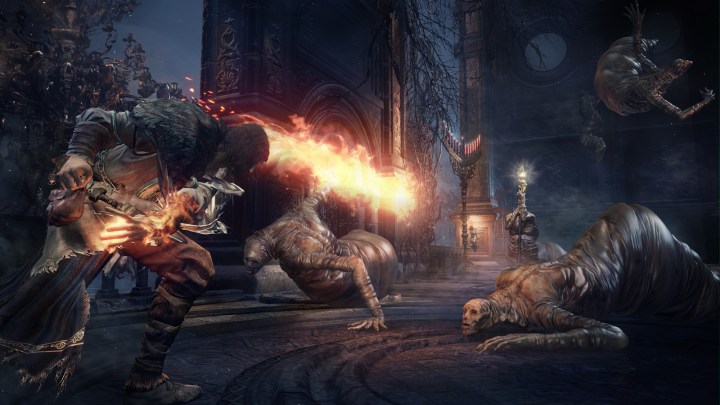
When a boss presents an opening for you to attack, you may be tempted to unleash everything you have. Don’t. It’s a surefire way to get you killed. Bosses in Dark Souls III rarely have a “weak” point that you can exploit for extra damage, and you don’t get any extra souls or items in the game for beating a boss within a certain time limit. Overextending yourself will, more often than not, leave you exposed just when your enemy is ready to resume its assault.
Once you see an opportunity to strike, get in a couple of good hits and then back off to prepare for their next attack. This should ensure that you never find yourself out of stamina, which will leave you defenseless against combo attacks. Backing away also allows you to take a look at the boss’ movements while you recover Stamina.
There are a few instances, however, when you have to throw caution to the wind and just attack like your life depended on it. The boss Prince Lothric, for example, is the only one of the two twins in the Lorian/Lothric fight who must be killed, but he’s capable of reviving his brother whenever the latter is defeated. Taking the extra time to recover and prepare for attacks will just make the fight drag on longer than it has to, forcing you to waste precious Estus Flasks or Embers. After a few trial runs, you’ll see when the best opportunities to strike will be, so make the most of them.
The Ringed City expansion also includes the bane of many Dark Souls players’ existence: multi-enemy boss fights. Instead of just focusing on when you have to attack an enemy and when you should retreat, you must concentrate on when to attack which enemies. The Demon in Pain/Demon From Below fight features two monsters that will change forms, with one relying on powerful long-range attacks while the other gets up close and personal. Failing to recognize their states will make the fight essentially unbeatable.
Look for alternative ways to kill enemies

Dark Souls III fights are difficult, but they’re also fair (usually). If you find yourself struggling to make progress — even against the most formidable of enemies — there’s a good chance that there is an alternate way to take them down. In the base game, you’ll encounter groups of praying enemies that, upon spotting you, will transform into a massive tentacle monster called “Pus of Man.” If it transforms, your best option is to run, but by rushing the only cultist who appears to actually be transforming and killing him, you can avoid the fight completely.
This even applies during boss fights, though you won’t have to worry about it nearly as much. Yhorm the Giant, a mandatory boss that you’ll encounter shortly before the end of the game, will seem absolutely impossible when fighting directly, especially if it’s your first time facing him. A sword located in the back of his room, however, is the key to defeating him, as just a few charged up attacks is enough to completely drain his health bar.
In The Ringed City expansion, you’ll be attacked by floating angels that fire light arrows capable of taking you out in just a few seconds. Instead of fighting them directly, you must search for a meat-wrapped skeleton protruding from the ground nearby. Take the time to familiarize yourself with every element of your surroundings, and you’ll never be caught off-guard. Sometimes finding your way can take a few tries, but that’s what Dark Souls III is about.
What is Ember and how do you restore it?
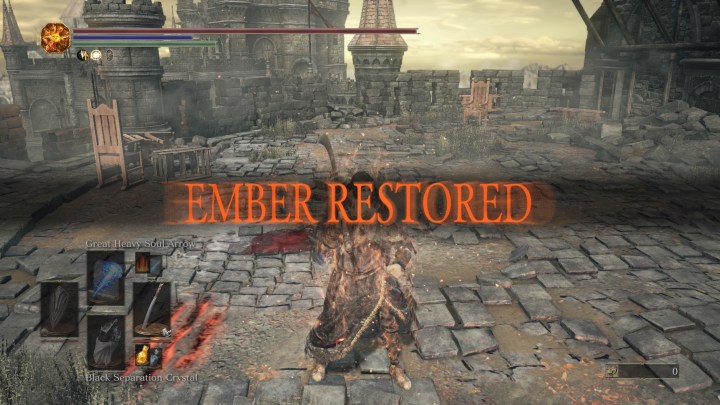
With all of the Souls games, there is a long-lasting consequence for dying. In previous entries, it was referred to as Humanity, and would dictate your character’s appearance and ability to play online. In Dark Souls III, it works similarly. Once you die, your total health depletes by 30% and negates your ability to summon or be summoned by other players online. To mitigate this, you’ll need to consumer Ember — an item that is found throughout the world, and can be purchased from various merchants throughout the game.
When you consume one Ember, your total health increases by 30% and you’ll be able to play online with others. Die again, and you’ll lose those perks. At first, you’ll want to focus on this less, as you’ll likely be dying a lot and figuring out how the game works. Don’t get too hung up on your total health either, as Ember is harder to come by at the start of the game. Once you’re comfortable, then you can start utilizing the Ember and playing online, but don’t waste it during the preliminary stages of the game.
Begin each encounter with full health (if possible)
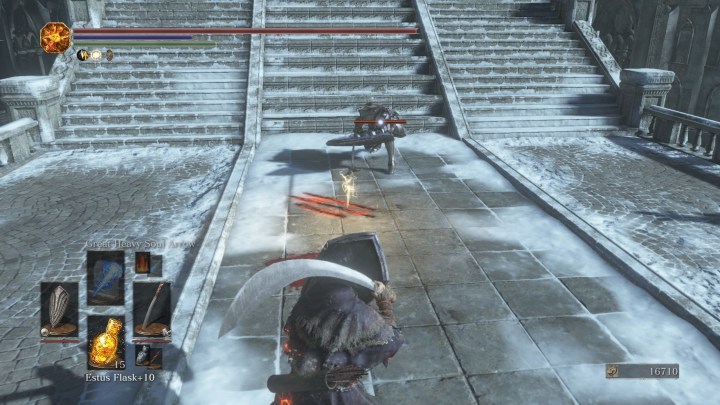
One mistake new players often make is not healing after each enemy encounter — thus preventing them from starting the next encounter with full health. Don’t do this. There are times, of course, when you literally won’t have healing items to use — and that’s okay. But if you have healing items, such as your trusty Estus Flask or a Divine Blessing, make sure you use them, especially before approaching another enemy. When you come across new enemies — ones who you’re unfamiliar with — it’s essential for you to have as much health as possible before engaging with them, as those enemies are likely to catch you off guard with an unexpected attack.
Let’s talk about parrying
Yes, we’re aware that parrying is intimidating for newcomers, but hear us out. The earlier you figure it out, the easier the rest of the game will be. Let’s start by explaining what a parry is: A parry is when you use a shield or other applicable weapon to deflect an enemy’s strike, opening them up for a devastating attack that will oftentimes take out a majority of their health. It’s a high-risk, high-reward maneuver because it requires pinpoint-precision timing that can be fatal if missed.
Not all weapons are able to parry and not all enemy attacks can be parried. As a rule of thumb, enemies who are around your size that use standard-size swords or smaller can be parried (with a handful of exceptions because it’s Dark Souls). We advise using a shield when attempting to parry, as you’ll likely want to have a shield with you at all times anyway. To tell if your weapon or shield is able to parry, check your equipment and look at the third option from the top, beneath the item’s name. If it says “parry,” you’re in good shape.
To countermove and ward off an attack, press the left trigger and use the weapon’s (in this case, the shield’s) heavy attack just as an enemy’s attack connects. Most characters will hold their shield in their left hand— if so, you’d press L2 on PS4 or LT on Xbox One. Play around with timing a bit because your success will vary based on your weapon and the enemy you’re facing. Keep in mind that you have to have a weapon or shield in your hand to parry — you can’t overwhelm them with your bare hands.
In the clip above, you can see exactly how to accomplish these steps. You can see how we deflect the Black Knight’s sword right as it came down (L2 on PS4 and LT on Xbox One). This move will shake him up and leave him vulnerable for your next critical attack. You won’t completely drain the Knight’s health, but you will damage it enough to finish the job with one more onslaught.
You can fight with adversaries from all around the world, as well as any real players. This tactic is excellent to practice early in the game when you’re facing weaker opponents.
Editors' Recommendations
- The best Palworld tips and tricks for beginners
- Cities: Skylines II beginner’s guide: tips and tricks to get started
- Dark Souls Remastered PC servers are back online for the first time since January
- Tunic beginner’s guide: 8 tips and tricks to get started
- Cursed to Golf beginner’s guide: 8 tips and tricks

